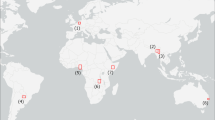Abstract
Flash floods can be characterized by several variables. Of these, soil moisture (SM) is an important environmental factor that plays a key role in hydrological and ecological processes and affects the mechanisms that cause flash floods. To more accurately determine the occurrence probability of flash floods, the combined effects of soil moisture and rainfall indexes were considered in this paper, and the copula function approach was explored for use in joint probability analyses of flash flood risks. The results showed that (1) the Clayton copula function offered the best fit for the bivariate joint distribution and captured the occurrence probability of the combination of both peak flow (PF) and SM, while the t-copula function achieved the best fit for the multivariate joint distribution, which presented different combinations of characteristic flash flood parameters. (2) The joint distribution probability of flash floods increased with increasing risk parameter thresholds. Return period analysis indicated that the return periods of the bivariate joint distribution were smaller than those of the multivariate joint distribution. (3) If PF and SM are fixed, the occurrence probability of flash floods is higher in regions where the maximum 1-h rainfall is higher. This study provides an effective and quantitative approach to improving flash flood prediction and advances the application of this approach for the management of future flash flood risks.




Similar content being viewed by others
Data Availability
Please see the attachment.
References
Dodangeh E, Singh VP, Pham BT, Yin JY, Yang G, Mosavi A (2020) Flood frequency analysis of interconnected Rivers by copulas. Water Resour Manag 34:3533–3549
Eugene ZXS, Wan ZWJ, Sai HL, Tanvir I, Prashant S (2019) Evaluation of satellite precipitation products for extreme flood events: case study in peninsular Malaysia. Journal of Water and Climate Change 10(4):871–892
Fan YR, Huang WW, Huang GH, Li YP, Huang K, Li Z (2016) Hydrologic risk analysis in the Yangtze River basin through coupling Gaussian mixtures into copulas. Adv Water Resour 88:170–185
Gan BR, Liu XN, Yang XG, Wang XK, Zhou JW (2018) The impact of human activities on the occurrence of mountain flood hazards: lessons from the 17 august 2015 flash flood/debris flow event in Xuyong County, South-Western China. Geomat Nat Haz Risk 9(1):816–840
Gastélum JR, Cullom C (2013) Application of the Colorado River simulation system model to evaluate water shortage conditions in the Central Arizona project. Water Resour Manag 27:2369–2389
Guerriero L, Ruzza G, Guadagno FM, Revellino P (2020) Flood hazard mapping incorporating multiple probability models. J Hydrol 587:125020
Gourley JJ, Flamig ZL, Hong Y, Howard KW (2014) Evaluation of past, present and future tools for radar-based flash-flood prediction in the USA. Hrdrol Sci J 59(7):1377–1389
Hesse R, Baade J (2009) Irrigation agriculture and the sedimentary record in the Palpa Valley, southern Peru. CATENA 77 (2):119–129
Hu H, Jun-Yi N (2015) Compensative operating feasibility analysis of the west route of south-to-north water transfer project Dased on M-copula function. Water Resour Manag 29(11):3919–3927
Lu Z, Ip HHS (2009) Generalized competitive learning of Gaussian mixture models. IEEE T Cybernetics 39(4):901–909
Ma Y, Lu M, Bracken C, Chen HN (2020) Spatially coherent clusters of summer precipitation extremes in the Tibetan plateau: where is the moisture from? Atmos Res 104841
Massari C, Camici S, Ciabatta L, Brocca L (2018) Exploiting satellite-based surface soil moisture for flood forecasting in the Mediterranean area: state update versus rainfall correction. Remote Sens 10:292
Nelsen RB (2006) An introduction to copulas. Springer, New York
Sklar A (1959) Fonctions de repartition an dimensions et leurs marges. Publ Inst Stat Univ Paris 8(1):11–12
Spainhour JCG, Janech MG, Schwacke JH, Velez JCQ, Ramakrishnan V, Bader M (2014) The application of Gaussian mixture models for signal quantification in MALDI-ToF mass spectrometry of peptides. PLoS One 9(11):e111016
Woodson MK, Sandor JA, Strawhacker C, Miles WD (2015) Hohokam Canal irrigation and the formation of Irragric Anthrosols in the middle Gila River valley, Arizona, USA. Geoarchaeology. 30(4):271–290
Wu H, Adler RF, Hong Y, Tian Y, Policelli F (2012) Evaluation of global flood detection using satellite-based rainfall and a hydrologic model. J Hydrometeorol 13(4):1268–1284
Zhai XY, Guo L, Liu RH, Zhang YY (2018) Rainfall threshold determination for flash flood warning in mountainous catchments with consideration of antecedent soil moisture and rainfall pattern. Nat Hazards 94:605–625
Zhang J, Lin X, Guo B (2013) Multivariate copula-based joint probability distribution of water supply and demand in Irrigation District. Water Resour Manag 30:2361–2375
Zhang Q, Li J, Singh VP, Xu C (2013) Copula-based spatiotemporal patterns of precipitation extremes in China. Int J Climatol 33:1140–1152
Funding
The research was supported by the National Natural Science Foundation of China (Grant No. 51709286 & Grant No. U1911204).
Author information
Authors and Affiliations
Contributions
All authors were involved in the production and writing of the manuscript. Conceptualization, M.Z. and T.J.; Methodology, T.Z.; Formal Analysis, M.Z. and T.Z.; Data Curation, H.W.; Review & Editing, X.C. and Y.H.; All authors have read and agreed to the published version of the manuscript.
Corresponding author
Ethics declarations
Conflict of Interest
The authors declare that they have no conflict of interest.
Consent to Participate
The authors declare that they consent to participate.
Consent to Publish
The authors declare that they consent to publish.
Additional information
Publisher’s Note
Springer Nature remains neutral with regard to jurisdictional claims in published maps and institutional affiliations.
Rights and permissions
About this article
Cite this article
Zhong, M., Zeng, T., Jiang, T. et al. A Copula-Based Multivariate Probability Analysis for Flash Flood Risk under the Compound Effect of Soil Moisture and Rainfall. Water Resour Manage 35, 83–98 (2021). https://doi.org/10.1007/s11269-020-02709-y
Received:
Accepted:
Published:
Issue Date:
DOI: https://doi.org/10.1007/s11269-020-02709-y




